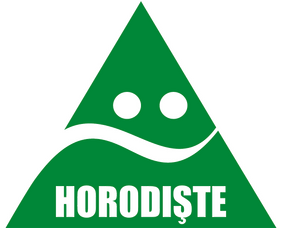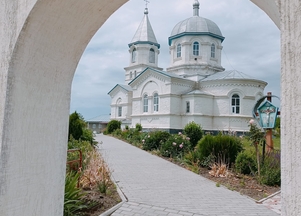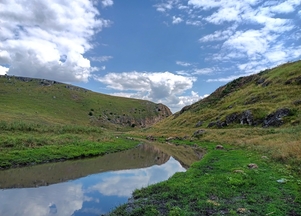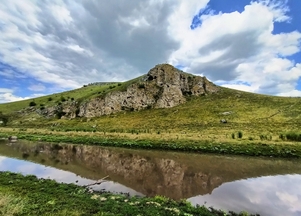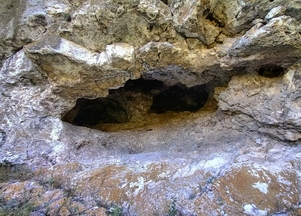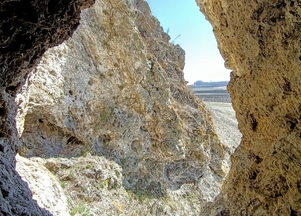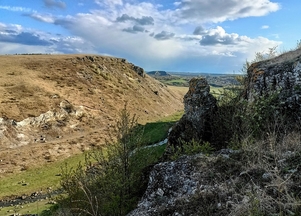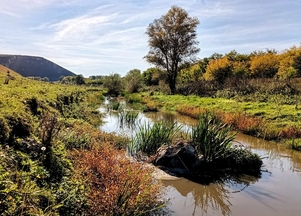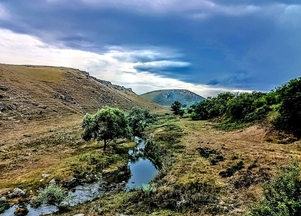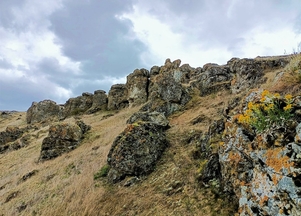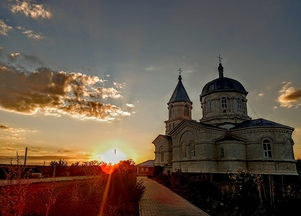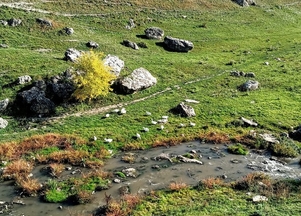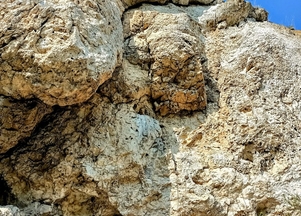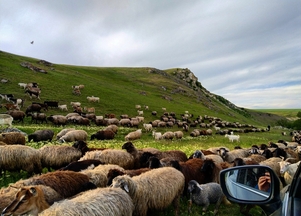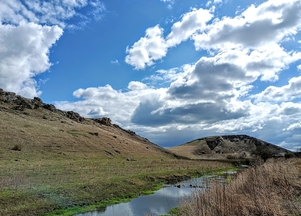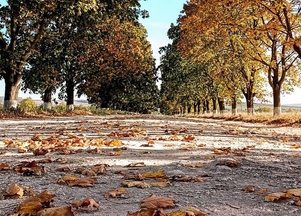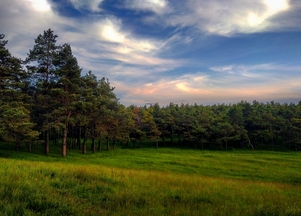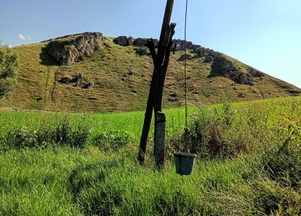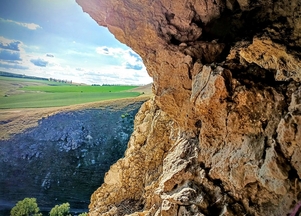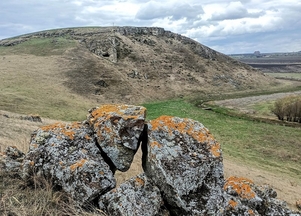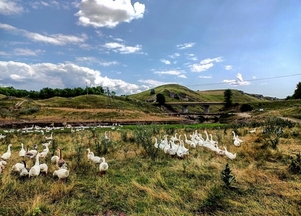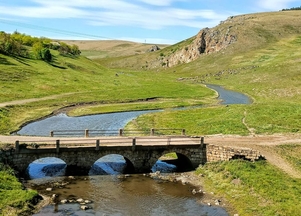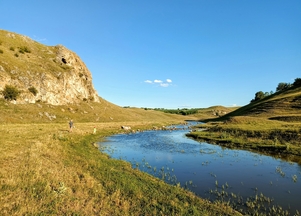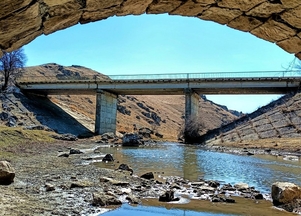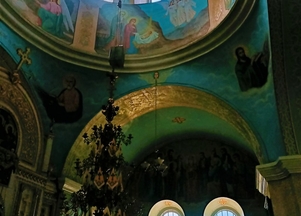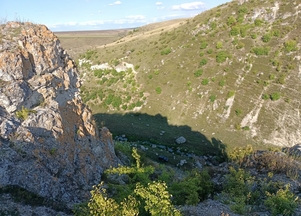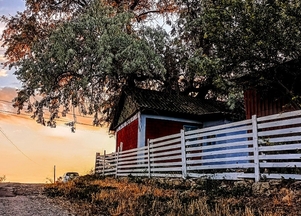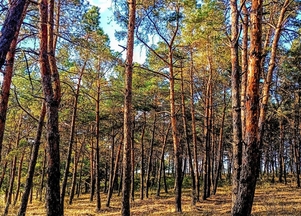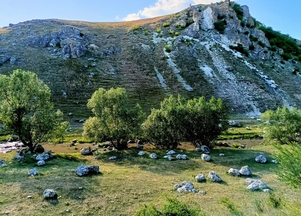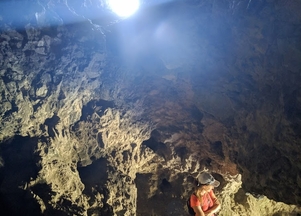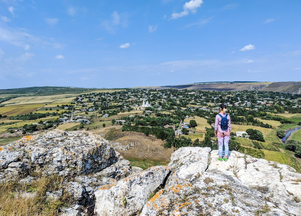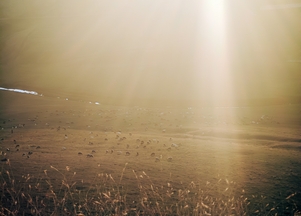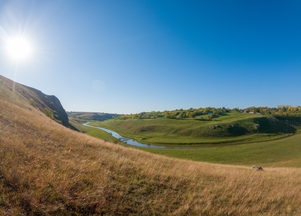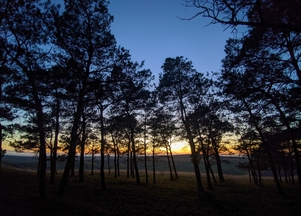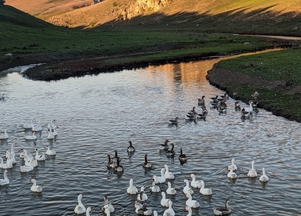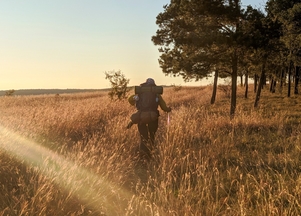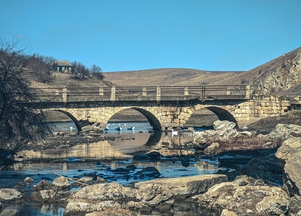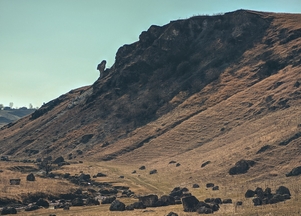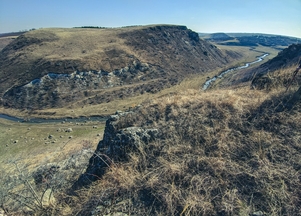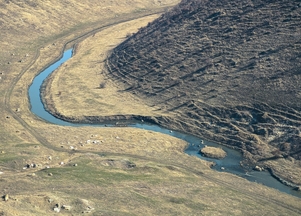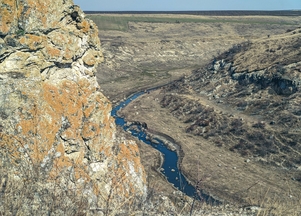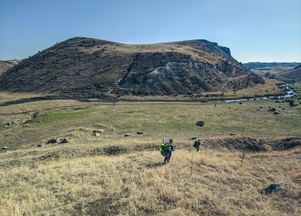Horodiște
History
The village of Horodiște is located in the north-west of Riscani district, on the right bank of the Ciuhur River, which flows from the surroundings of Ocnita and flows into the Prut River. In the northern part of the village on the left side of the river there are picturesque cliffs over 130 m high, called Holm, with a huge cave "Țiglău", where the locals used to take shelter during emergencies.
The feast day of the village is on Great Sunday, and the village is documented on 3 July 1429.
Archaeological excavations show traces of human activity dating back more than 70,000 years, when prehistoric people settled in the cave on the edge of the present village. Flint objects and tools have been found here. The middle layer of the cave contains flint objects dating from the 12th-11th millennia BC.
In the Neolithic period (10,000 - 12,000 years ago) human settlements appear, people settled in this cave.
From the beginning two villages were founded, and later two more. The inhabitants built their houses of wood and clay, herded cattle, farmed, practised various domestic crafts, etc. The development of the villages was halted by a fire. When Dacia was conquered by the Roman Empire, two villages were founded on these sites, where free Dacians lived, ploughed and sowed the land, raised cattle, and had trade links with merchants in the cities of the Roman Empire. These villages were again devastated and burned down following the Hun invasion. As a result of the migration, new settlements emerged. Settlements were located along small rivers, which formed hamlets of 3-5 settlements. One of these hamlets was our village. Archaeologists describe a rectangular shaped settlement on the territory of these settlements, located at a depth of 130 cm from the ground level, oriented on the East-West axis. On the steep bank of the river Ciuhur there are traces of a fortress with moat and mound, built during the migration period to serve as a place of refuge during enemy invasions. In different periods, nomadic tribes of shepherds passed through the area, leaving seven burial mounds.
On June 3, 1429 in a book from the Suceava court of Alexander the Good, a settlement on Ciuhur with the name "Horodiște" is mentioned.
The name of the village comes from the Slavic word "Огородить" (to fence). In the past there were fences that protected the village near the border. This is also the origin of the name of the village of Horodiște - "Городище" (fortified settlement). In 1541, in his second reign, Petru Rares, enthroned by the Turks, waged a series of wars and built the great monastery of Probolta. He gave estates and villages to army commanders and brave soldiers "for righteous and faithful service". A document says that "By the mercy of God we, Petru Voievod, ruler of the country of Moldavia... and Oprea Ungureanu served us justly and faithfully. Therefore.. we give a village on Ciuhur, namely Horodiște, which that village .... and grandchildren and great-grandchildren and their entire lineage who will prove most faithful forever".
On September 4, 1605, the ruler Ieremia Movilă gifts a number of villages to the Dragomirna Monastery, including Horodiște on Ciuhur...
The Tsarist times
The toponym Basarabia was applied to Bugeac, a small strip north of the mouth of the Danube, which was under Ottoman rule. After 1812 the territory between the Prut, Dniester, Danube and Black Sea was annexed by Russia. Bessarabia was divided into 8 counties. The counties were divided into districts. Tens of thousands of Bessarabian peasants, including those from the village of Horodiste, groaned under the colonial yoke. Many Bessarabians were displaced to the Caucasus and Siberia, where Moldovan villages are still preserved today. The Russian Empire succeeded in almost 6 centuries of division and domination. The Tsarist government decided to carry out an agrarian reform out of fear of losing control. At that time there were 49 families living in Horodiste, 48 of which were given 9.5 ares of land.
Later the town experienced a social and economic rise. There were two water mills in the village belonging to Nicolae Rosetti Roznovanu and his wife, Ecaterina Ghica Roznovanu (the countess who owned and then sold the estates of Pociumbeni and Druță to the landlord Teodor Vârnav, the first Romanian memorialist). Ecaterina Ghica also owned the manor in Lipcani, where she was buried, and the church from the small town with the parish of St. Ecaterina was in honour of the countess. The countess also wrote a complaint in the 1860s in which she asked the county authorities to stop deforestation around the village of Horodiște.
In 1865, among the Russian landowners who owned large estates was the landlord Gheorghe (Egor) Rîșcanu, who owned 6000 ares. He lived on the lands of the present day Riscani district. Hence the name of Riscani district. He owned the following settlements - Rîșcani, Ochiul Alb, Grinăuți , Brătușeni, Druță , Moșeni and Horodiște with 489 inhabitants. Gheorghe Rîșcanu had a family with 4 children - Alexandru, Jorj, Maria and Vera. In order to keep the population in check, the tsarist government had large armed contingents deployed in the governorates. The "Voznesensky Polk" (military brigade) was stationed in Balti. Ivan Dimitrievich Bursky was assigned to this military unit from Siberia and married Maria, daughter of G. Rishcanu. When he gave his daughter Maria in marriage, her dowry included the Horodiște estate and the village with the same name. After his marriage Ivan Bursky helped by his father-in-law, went into the reserve and consolidated all his activity on the estate where he lived until 1922. With the move to the estate, Ivan Burrsky became an administrator, but also ,,Zemskii nacialnic,,- head of the local administration. The landlord gave cattle and other valuable gifts to the locals. Two children were born into the landlord's family - daughter Cococica and son Vladimir. The daughter was viciously ill and died young. Vladimir was a clever boy, studied abroad and knew 5 languages. Some claim that Vladimir may have met the Tsar's daughter Olga and even intended to marry her, but his concussion in the First World War thwarted all intentions.
Vladimir Bursky later married a woman who worked at his court named Olga. He lovingly called her Olicica. They gave birth to a girl named Galina and a boy named Pachia. Galina married Malut of Erimia Gurău. During the Second World War, in 1944 fortifications were being built along the Prut. Young girls and women, who had only one child each, were mobilised and forced to dig trenches. Galina developed pneumonia, she did not recover and died. Pachia was born in 1925 and after marriage had three daughters: Valentina, Maria and Silvia...
Under the Russian Tsar's decree, the landlords were obliged to build a school and a church in their villages. In the village, a church was built of wicker on a stone foundation. This church was built with the money donated by Ivan and Maria Bursky. Around 1907 the building project was approved. The plan of the church and cemetery has been preserved. According to the inhabitants, the stone church was built on the site of the old wooden church in 1906-1907 and consecrated on the Great Sunday in 1914. Father Sordun from Văratic was ordained as priest. Others claim that the first priest was Father Zorilă from Pociumbeni. In 1962 the local authorities put a lock on the church door. After 26 years, in 1989, the first Christian mass was celebrated. On the feast of the Great Sunday, the church and the village celebrate their feast day (Hram).
Between 1901 and 1904, a school with two primary classes was built with education in Russian. In 1908 the pupils stopped attending the school, which reopened in 1910 with 30 pupils.
Between 1918 and 1940 there were 4 classes taught in Romanian. In 1948, 7 classes were taught, with Mihai Leontev as principal. Between 1952 and 1961 a new school with 8 classes was built.
1912-1918
An event that shook humanity at the beginning of the 20th century was the First World War 1914-1918. In 1914 Bessarabia was under Russian rule and the men of the village were mobilized in the Tsarist army. Vladimir Bursky and others were called up. Some villagers were taken prisoner by the Germans. Vladimir Bursky suffered a concussion in one of the battles and did not fight again. He died during the famine in 1946.
The family vault still stands today on the grounds of the centuries-old church, the only one in the region that was not subjected to Soviet transformations, but was only closed after all the women, including pregnant women with small children, lined up in front of the church in peaceful protest and opposition to the church becoming a mere warehouse. Today there are still the manor cellars, the vault, the church and some photographs.
The Russians, being preoccupied with their own problems, paid less attention to the settlements. This encouraged the Basarabians to proclaim their independence, electing their first parliament - the Country Council - in 1918. Erimia Sofronie, a native of Horodiște, was among its democratically elected members. On 27 March 1918, the Declaration of Unification with Romania was signed. The village of Horodiște became a district in the Balti county.
In 1946- 1947 there was a great drought and terrible famine. The peasants were burdened with various taxes - "postavcă". Those who could not pay the "postavca" were deported to Siberia and Kazakhstan. Accused of not fulfilling their obligations to hand over agricultural products to the state, 36 people were deported from the village of Horodiste. Two years later, forced collectivisation began. The "socialist period" commenced.
Legend
The etymology of the name of Horodiște
In the Russian-Moldavian dictionary we find such a translation of the word ,,Гoродище,,- archaeological land, remains of a prehistoric settlement.
- The following legend claims that the name of the village comes from the name of the farmer who founded the village, Horodișteanu. At that time people built their houses further away from Cihur. A certain local, nicknamed Horodișteanu, built his house on the bank of the Cihur not far from a spring that had cold and crystal clear water. People from the village came to fish and also to see Horodișteanu's household on the bank of the river where farmed vegetables. He had rich harvests, fished in the river and his cattle was grazing on the nearby pastures. When someone from the village went to fetch water from the spring, people would ask: - Where are you going? - To Horodișteanu. - Where are you coming from? - From Horodișteanu. The people, seeing the advantages of the river, started to build houses on the river bank.
- Another legend told by an old man from the village says that when the lord of the Horodiște estate Gheorghe Rîșcanu took his party hunting fo game, they reached the high place of his estate at Movili. Looking on the Răcovățului side he saw smoke coming out. At the suggestion of a guest they set out for that place. When they approached they saw that about a dozen families of fugitive peasants were sheltering near a spring, which to this day they call Sipot. In conversation they confessed to being of the Chistreni name. The landlord told them that these lands belonged to him and if they wished they could stay here, but there was a better settlement near the river and it was also near the spring, on the bank of Ciuhur. The river with clean water, the fish, the spring with clear, cold water impressed the Chistreni and they settled there.
Toponyms of the village Horodiște
The spring of Cucoană. This spring in Horodiste is located in the north-west part of the village, on the outskirts and was built by the nobleman Ivan Bursky in honour of his only son Vladimir. People used to call it "the spring of the offspring", but over time it reverted to the original name, the spring of Cucoana (Mistress).
The Lupoaie Spring. This spring is located on the right bank of the Ciuhur river near the old and twiggy willows further downstream from the small barn, until it reaches the Holm Barn. It was built of stone by a householder named Nichita Lungu, who had the nickname Lupu (the wolf). During his lifetime he took care of the spring and the surrounding area.
For decades people used to cross the river through the ford - a place on the water course, where the bank is lower and the water shallower, allowing water to flow from one bank to the other. But in 1967 at the initiative of locals Nicanor Cologhin and Ion Sitnițchi, the people of the village built the Little Bridge over Ciuhur. Vasile Zbârciog was the watchman for supervising the materials. After the construction was completed, the bridge was consecrated at night by a priest from Pociumbeni. Even today, carts and tractors are still used, cattle are taken to pasture on this bridge, next to the Great Bridge built in 1980.
The spring of Șipot. The name "Șipot" comes from the verb "șipoti", to spring. It was built at Răcovăț. In the past, about 12 families of runaway peasants used to shelter near this spring with its crystal clear fresh water.
Beautiful places
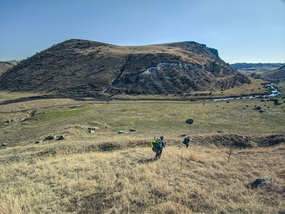
The Rock of Evil Spirits
One could write a book about the Rock of Evil Spirits! It is probably the most mysterious rock in the north of the country, and still undiscovered to the end. Moreover, the villagers have blocked access to the depths of the cave, which is said to be endless.
Read more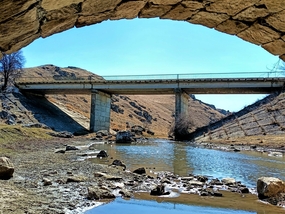
Horodistei bridges
As the whole village stretches only on the right side of the river Ciuhur, like all the villages in the perimeter of Ciuhur, the bridges are specific to the villages on Ciuhur. The only exception is the village of Druță, which is situated on the left side. This is the reason tha, in the past, Druța was called Stângăceni
Read more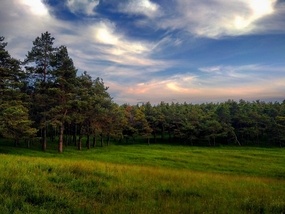
"Pine forest"-Bulhac
"Pine forest" Bulhac On the left side of the gorge you can see the pine forest, called by the villagers, but also by the Soviet cadastral maps - Bulhac. On the top of the cliff there is probably the only karst lake in Moldova. It is of perfectly circular shape, and is located at an altitude of over 100 meters above sea level.
Read more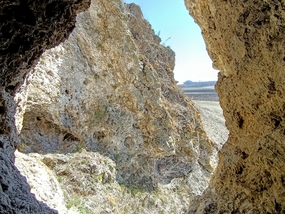
The Țiglău Cliff / The Echo Grotto
At the foot of the pine forest, the rocky Țiglău Cliff rises up. With its unique acoustics, the Țiglău cliff, (the name is said to mean mountain head) has two of the most spectacular caves. One is in the perfect shape of a circle with a diameter of 4 meters at the entrance, with millennia-old fire marks on the cave's vault.
Read more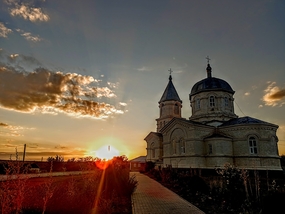
The Centennial church and the Bursky lords' vault.
The church of the village of Horodiște, an architectural jewel designed in the early 1900s with the support of the Bursky boyars, was built in 1912 by a mason from Odessa. It was the only church in the district that did not undergo any changes in its use, such as a warehouse or other functions that were foreign to the church.
Read more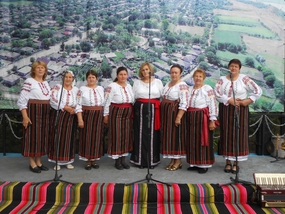
The "Ciuhureanca" Seniors Group
And if you have exhausted your strength on the rocky lands of Horodistea, we invite you to an authentic artistic break. The senior ensemble "Ciuhureanca" is the village's calling card at various national and international festivals
Read more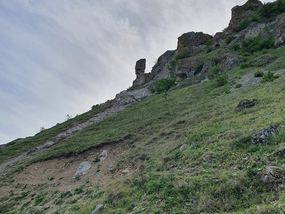
Sphinx of Horodiște
The "Sphinx of Horodiște" is a rock prominence once artificially excavated. The image of the sphinx is more attractive from the village of Druță, where you can see its outline better, but also because it forms a perfect contrast for photographs, with the west behind it.
Read more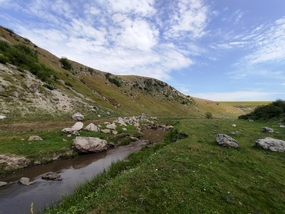
Canyon Horodiște
The canyon with millenary rocks hides 5 larger caves (with a diameter at the entrance of 2 to 4 meters) and many others in the form of burrows with a diameter of up to 1 meter. It should be mentioned that, for a more spectacular hike and for a gradual discovery of the canyon of Horodiște, it is recommended to start from the village of Druță.
Read moreFigures
Erimia Sofronie , member of the County Council.
Gheorghe Anton, 1937-2019 , since 1979-head of radiology department at the Republican Clinical Hospital, secretary of the Council of the Scientific Society of Radiology and Nuclear Medicine, lecturer at USM ,,N.Testimițanu". He has 32 scientific publications and 15 inventions applied in practice. For outstanding merits he was awarded the medal "Eminent of Health Protection".
Pavel Anton, born 1936, assistant, senior lecturer, university lecturer, deputy dean at the University of Arts in Chisinau, for more than 25 years conducted the choir of the institution, receiving the title of Popular Choir. He is co-author of textbooks for the 2nd grade, methodical indications for grades II-VIII, member of the Republican Choral Society, since 1989 - university professor, decorated with the insignia ,,Eminent in education and culture" and the small gold medal of the USSR trade unions. In 2002 his volume of romances appeared.
Ion Grigoire Brus /1939-2013/. Physician, doctor of medical sciences, senior lecturer at USM ,,N.Testemitanu", specialist in the field of operative surgery and tomographic anatomy, published 51 scientific works, decorated with the medal and badge ,,Emeritus Physician of RM".
Ion Anton, (1948-2022), graduate of the Faculty of Law of USM. Between 1976 and 1984 he worked at the Camenca Court, member of the Supreme Court of the Republic of Moldova, in 1990 he was the first Deputy Minister of the Republic of Moldova.
Vlad Zbârciog, born 1943, graduate of the Tiraspol Medical School, then of the USM Faculty of Journalism, writer, poet, essayist, publicist. He has published more than 40 volumes, which have been translated into Russian, English, French, Italian, Turkish, German and Ukrainian. He was secretary of the Writers' Union, awarded the Prize of Excellence of the Writers' Union of the Republic of Moldova, was awarded the title of Master of Literature.
Ana Sofroni, born 1947, graduated from the Balti School of Medicine, then from the USM School of Librarianship, lecturer, doctor of pedagogy, university lecturer, first librarian in Moldova, published 43 specialist works, poems. She is a member of the "Metropolitan Varlaam" society.
Nicolae Brus, /1934-2010/, teacher, director of the high school in Băcioi village, vice minister of education, author of the book about his native land, "Horodiște - cradle of dreams and longing".
Victor Moraru, born in 1950, graduated from UTM, the faculty of engineering-construction, then from the Higher Party School in Rostov-on-Don (1985), the MoI Academy of the USSR (1988), the Bucharest Police Academy, PhD (1998), Doctor of Law. He is author and co-author of 12 textbooks, 2 monographs, published 18 articles in Moldovan and international journals, 5 scientific communications, expert in international programs at the Institute of Penal Reforms, awarded the medal ,, Civic Merit".
Valeriu Zbârciog, born in 1948, graduated from UTM, Faculty of Engineering and Economics, then from Moscow, M.Lomonosov University, PhD in Economics, 1983, senior lecturer at UP Chisinau, professor at the Academy of Economic Studies, honorary dean at the Faculty of Transport, Informatics and Telecommunications, professor at AAP, author of about 100 scientific papers.
Vasile Gorodișteanu, (1937-1984), specialized agronomist, president of the collective farm, director of the Horodiste communal farm, for his dedicated and abnegation work was decorated with "Labor Glory" and "Civic Merit".
Mikhail Leontiev (1913-2010), teacher at the village school, headmaster from 1944-1962. In 1962 the school was opened for 8 years under his direction.
Scutelnic Gheorghe, b.1961, graduate of the Faculty of Law of the USM, worked as a judge in the town of. Edineț, he was President of the Court of Appeal Balti from 2008 to 2016, Vice-President of the Court of Appeal Balti.
Petru Brus, born 1958, graduated from the College of Viticulture and Winemaking, studied at UTM, worked at the Zubresti wine production factory, since 1996 has been presenting his production at international fairs in England, Poland, France, Austria, CIS countries.
Ion Grîu, (1920-1995), brigadier in the collective farm, president of the Terebna village, Edineț, collective farm; in 1958 he was elected deputy in the Supreme Soviet of the USSR, president of the trade union organization in the village.
Video presentation
In the following video presentation, you will be invited to discover the beauty of the banks of the Prut River in the Republic of Moldova. This picturesque area is known for its idyllic landscapes, where the river Prut flows quietly through the hills
photos by Olivia Furtună - https://www.facebook.com/o.furtuna.e


 ro
ro
 ru
ru
